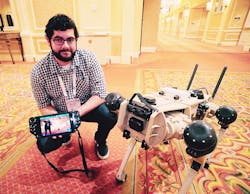According to the Las Vegas Convention & Visitors Authority, pre-COVID spending by visitors attending trade shows like ISC West directly contributed to over $6 billion and made up over 15% of the city’s total tourist volume. Is the convention industry returning to normal and how many industry professionals are seeing the latest advancements in industrial security? If gaming were a barometer, dealers at MGM are on the way to breaking $100K individual earnings this year, not having eclipsed that milestone in 40 years. The ISC show floor estimates are a conservative 10,000 attendees, however; even with a smaller show space, security and safety solutions advanced in many categories, both in new product introductions and those receiving new product showcase awards.
Boon Edam
In the growing optical turnstile access control market, the need for ADA compliant touchless, frictionless entry solutions has led Boon Edam to introduce their shortest optical turnstile, the Speedlane Compact. This latest premium entry control has the shortest smooth, swinging motion glass barrier of the line, and includes tailgating detection. Although it has a smaller footprint, it is still wide enough for the average wheelchair. Object detection sensors are included as standard, and there are available options of IP cameras by Axis Communications and facial recognition by Anyvision, with simplified enrollment at the turnstile.
OptaSense
At the first face-to-face meeting of SIA’s Public Safety Interest Group, virtual attendees from the Houston and Cleveland emphasized the need for enhanced perimeter detection on a large scale to support supply chain, utilities, petroleum, water, and telecommunications infrastructure. With their experience in long distance protection of South American pipelines, Houston-based OptaSense introduced a Perimeter Intrusion Detection System (PIDS) that uses a single strand of single-mode fiber to detect acoustic activity and advanced software algorithms to identify actual threats, reject false alarms and greatly reduce operator alarm fatigue. Deployment can be as simple as lighting, terminating, and testing buried, dark fiber over a distance as great as 60 miles (50km). The OptaSense PIDS, a SIA New Product Showcase Award winner, also leverages a newly announced relationship with PureTech Systems’ video surveillance solution that automatically detects, classifies, tracks and alarms on objects of interest. OptaSense PIDS map and acoustic recognition can be displayed on large format or mobile HD devices.
M2M Services
With most smartphones having an MSRP greater than $300, some sophisticated alarm transmission devices now follow the “hardware as a service” model, allowing program managers to use a “pay as you go” plan. To achieve this, M2M Services includes highly reliable Dual-SIM hardware, supporting both AT&T and Verizon. The Model MQ03-LTE-M-FIRE was an Innovation Awards Winner at ESX 2021 and Model MiNi-LTE-M-AV is this year’s SIA New Product Showcase Award Winner in the Communication and Networking Solutions Category. The “Fire” model also includes four monitored inputs and two outputs, allowing pre-alarm signals to be detected with IP cameras having smoke detection analytics, if approved by the local authority having jurisdiction (AHJ). Remote upload/download is available to selected Honeywell, DSC, and Interlogix panels.
Ghost Robotics Q-UGV "Dog"
From incubation to growth in the University of Pennsylvania’s Pennovation Lab around 2016, Ghost Robotics moved rapidly to become a leading solution provider of quad-legged autonomous unmanned ground vehicles, or Q-UGV. These “Robots That Feel the World” can navigate unstructured terrain and harsh environments, especially useful for military, homeland security and local law enforcement applications. The relatively low cost and size-scalable (1–4 feet in length) platform is extremely agile.
I was fortunate to have one of Ghost Robotics’ development team leaders offer a demonstration. As I moved around to take a picture, I noticed how their Vision 60 4th Gen Q-UGV instantly moved to block my path, mimicking an agile canine. It’s no accident that Tyndall AFB 325th Security Forces is the first to deploy “persistent” security robots. These prototypes come equipped with advanced multi-directional, thermal, and infrared video capabilities that provide artificial intelligence-based threat detection, and are similar to the Q-UGVs attracting crowds at this year’s ISC West.
“The command and control of these is actually pretty intuitive,” said Maj. Jareth Lamb, Force Protection Modernization Branch chief. “They come with a control pad and joystick, so for anyone who’s ever played a video game before, you can easily pick it up and be able to control the full range of capabilities on these robots with minimal training.”
From disarming IEDs, to safely navigating a path across a frozen lake, the Vision 60 Q-UGVs are a leap forward in life-saving, high risk applications.
About the Author:
Steve Surfaro is Chairman of the Public Safety Working Group for the Security Industry Association (SIA) and has more than 30 years of security industry experience. He is a subject matter expert in smart cities and buildings, cybersecurity, forensic video, data science, command center design and first responder technologies. Follow him on Twitter, @stevesurf.




